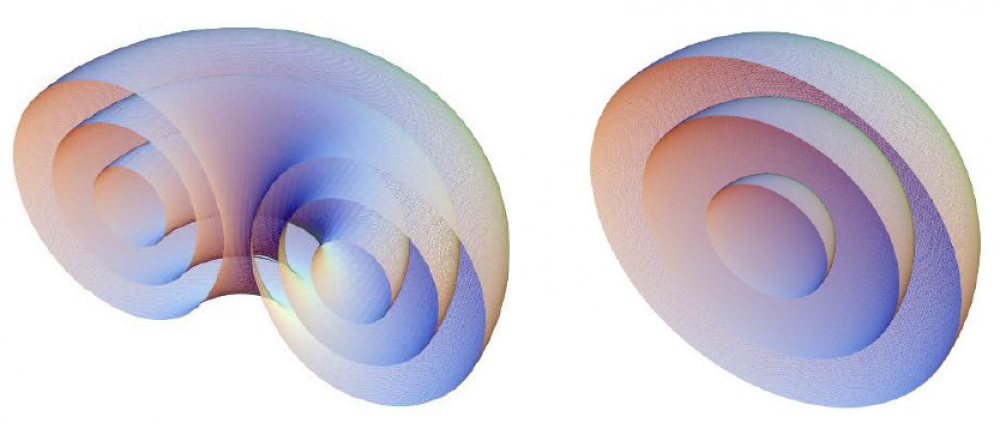A long standing problem in General Relativity has been the dynamical properties of spinning bosonic stars. In the paper "Non-linear dynamics of spinning bosonic stars: formation and stability", to appear in Physical Review Letters, the dynamical behaviour of these objects has been unveiled.
A collaboration between Aveiro U., IST-Lisbon and Valencia U. (Spain), including N. Sanchis-Gual, F. Di Giovanni, M. Zilhão, C. Herdeiro, P. Cerda-Duran, J. A. Font and E. Radu, performed fully non-linear evolutions of the formation and evolution of both scalar and vector spinning bosonic stars. The results have been both enlightening and surprising.
This webpage exhibits visualisations of the numerical simulations presented in the paper showing the formation and evolution of spinning bosonic stars in different cases. The videos show evolutions of the scalar/vector energy or angular momentum density, on the equatorial plane of star/cloud. In all cases the time is in units of the mass of the scalar/vector field.
Video 1: Evolution of the energy density of a scalar spinning bosonic star.
Up to time ~2000 the star remains essentially undisturbed with its toroidal energy distribution. Subsequently, a non-axisymmetric instability develops and fragments the star into two main pieces, which, nonetheless, remain bound and recollapse, forming a black hole. This is model 1S in the paper [arXiv:1907.12565]. See this paper for details.
Video 2: Evolution of energy density of a scalar spinning bosonic star.
Same as video 1, but now for configuration 2S in the paper, which is more compact. Now the instability kick in earlier, around time ~1000. This is the evolution shown in Fig. 3 in [arXiv:1907.12565].
Video 3: Formation scenario of a scalar spinning bosonic star; evolution of the energy density.
Starting with a dilute, spinning scalar cloud, gravitational collapse makes it more compact. The star stars to oscillate radially, ejecting mass and angular momentum (gravitational cooling). Around time ~4000 however, a non-axisymmetric instability kicks in, fragmenting the star. The star splits into a roughly symmetric orbiting binary. The binary recollapses to a deformed spinning star, around time ~6500. This star breaks into two asymmetric pieces, which again recollapse into a spheroidal star with angular momentum. This residual star is still evolving, likely towards an asymptotic final state of a spherical star with no angular momentum. This is the evolution shown in Fig. 2 in [arXiv:1907.12565], first column.
Video 4: Formation scenario of a scalar spinning bosonic star; evolution of the angular momentum density.
Same simulation as in Video 3, but now showing the angular momentum density, rather than the energy density. This is the evolution shown in Fig. 2 in [arXiv:1907.12565], second column.
Video 5: Evolution of the energy density of a perturbed vector spinning bosonic star.
A vector spinning bosonic star is initially perturbed, with a sufficiently large perturbation to visibly change its morphology. Nonetheless, the start dissipates the perturbation, resumes its equilbrium shape and keeps its angular momentum. This is the evolution shown in Fig. 4 in [arXiv:1907.12565], first column.
Video 6: Evolution of the angular momentum density of perturbed a vector spinning bosonic star.
This is the same evolution as in Video 5, but now showing the angular momentum density. This is the evolution shown in Fig. 4 in [arXiv:1907.12565], second column.
Video 7: Evolution of the energy density of an excited vector spinning bosonic star.
The excited spinning Proca star has a Saturn-like energy distribution, because it has nodes. The evolution migrates it the fundamental, lowest energy family. This is the evolution shown in Fig. 4 in [arXiv:1907.12565], third column.
Video 8: Evolution of the angular momentum density of an excited vector spinning bosonic star.
Same as in Video 7 but now showing the angular momentum density. This is the evolution shown in Fig. 4 in [arXiv:1907.12565], fourth column.
Video 9: Formation scenario of a vector spinning bosonic star; evolution of the energy density.
Gravitational collapse occurs towards a more compact object, with the gravitational cooling mechanism at play, as both energy and angular momentum are being ejected in the oscillations of the star. No evidence of an instability ejecting larger fractions of the angular momentum is found. This is the evolution shown in Fig. 2 in [arXiv:1907.12565], third column.
Video 10: Formation scenario of a vector spinning bosonic star; evolution of the angular momentum density.
Same as in Video 9 but now showing the angular momentum density. This is the evolution shown in Fig. 2 in [arXiv:1907.12565], fourth column.
